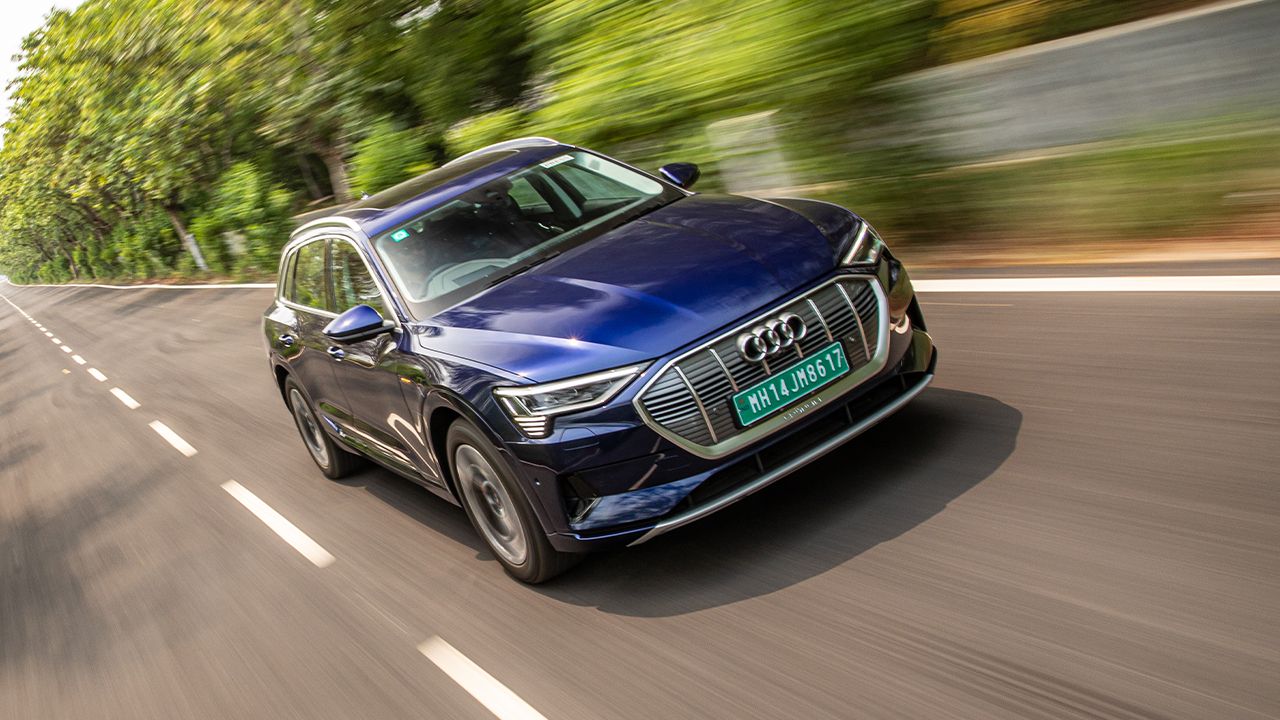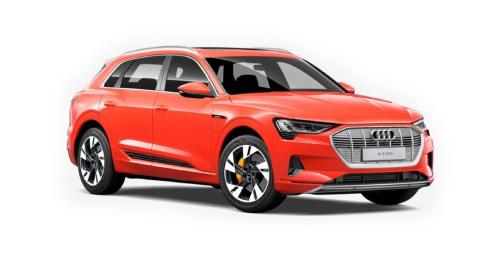Audi’s first-ever production EV is here to shake the conscience of luxury car buyers. But is the e-tron a mere exercise in virtue signalling or can it really walk the talk?
Every time the word ‘EV’ is uttered, someone somewhere loses their mind. It may seem like hyperbole, but there is some truth to it. And that’s because people resist change. Breakthrough innovations, as history tells us, always attract more detractors than supporters. And when it comes to cars, we are all a bit more emotional than usual. So, forcing a new technology or an idea down our throats is sure to encounter more resistance than what’s conventionally expected.
However, one doesn’t need the red pill to open their eyes to the truth that electric cars are the future, irrespective of whether you are ready for them or not. To give you some perspective, global EV sales grew by a whopping 41% in 2020 – this happened at a time when global car sales dipped by 16% and the world was fighting the COVID-19 pandemic. What’s more, in the first quarter of 2021, EV sales grew by 141%, with global sales hitting a total of 1.1 million units! Electric vehicles, it seems, are being lapped up by the masses faster than we imagined.
So, is it about time that we start taking EVs seriously? Well, the answer is a bit more complicated. You see, if electric cars are to be the future, then they need to be as good, if not better, than their ICE counterparts. It means that they should offer similar or better levels of comfort, performance, features, reliability, and practicality. However, most of the EVs that we’ve driven in recent times seem to lag behind their ICE counterparts in one department or the other.
But now, there’s a new EV in town – the Audi e-tron – and it promises to be just as good as its petrol or diesel-powered siblings. Another tall claim, or is Audi really onto something here?
Sticking to the norm
Unveiled in 2018, the e-tron is Audi’s first-ever fully-electric mass-production vehicle. It was supposed to be here in 2019, but the launch got delayed by nearly two years.
With the e-tron, Audi is making no bones about this EV – they don’t project it to be some outlandish concept that’s here to turn the world on its head. Instead, Audi has decided to market it as somewhat of a conventional car with zero tailpipe emissions. As a consequence, the e-tron looks quite similar to the Q5 and Q7. And that’s no surprise because it’s based on the same MLBevo platform as its Q counterparts.
However, the platform has been heavily modified for the electric drivetrain. Size-wise, the e-tron slots between the Q5 and Q7. That said, there’s no getting around the fact it’s quite a heavy car – it tips the scales at nearly 2.5 tonnes. The battery pack alone weighs 700kgs.
Although its design is not as outlandish as some would expect from a car with the word ‘tron’ in its name, it subtly differentiates itself from its regular counterparts – the octagonal single-frame grille finished in platinum grey, the massive 20-inch wheels with orange brake callipers, e-tron monikers splashed all over the bodywork, and the tail-lamps, made up of LED strip, running across the width of the car come together to give the e-tron a sense of individuality. And did I mention that there are no exhaust pipes? Overall, it’s a very understated looking car – not great, not terrible.
The interior is modern and techy, but you won’t find anything extraordinarily different from regular Audis. Similar to that of the A8 L and Q8, the e-tron’s cabin features a dual-touchscreen setup – one for infotainment and the other for climate controls. The latest MMI system works like a treat and is very easy to use. The screens are of amazing quality and have haptic feedback for improved sensitivity – sometimes, however, you might find yourself pressing the screen too hard to work your way through different menus.
Audi’s brilliant and full-HD Virtual Cockpit sits in front of the driver and offers big and clear readouts. It’s without a doubt the best digital driver display in the industry. Standard features include a Bang & Olufsen sound system, wireless phone charging, a head-up display, a panoramic sunroof, four-zone air-conditioning, and so on. Oh, and it also gets the fancy soft-door closing feature.
The centre console design is unique, if a bit busy, and there’s a new type of gear-selector, which is integrated under a hand rest. Although not as intuitive at first, it looks quite classy. Sadly though, the India-spec e-tron doesn't come with virtual wing mirrors – Audi tells us that it has been given a miss based on feedback received from prospective customers. A bit of a downer is what it is.
On the upside, the cabin is studded with high-quality materials and offer an impressive amount of space. With a flat floor at the back, the e-tron’s rear bench is much more spacious, comfortable, and practical than regular Q SUVs of similar size.
Nuts & Volts
Propelling the e-tron is a 95kWh lithium-ion battery pack, which powers two electric motors – one at each axle. The total power output stands at 402bhp, and the system develops 664Nm of torque. However, these figures are just headline-grabbers. In regular driving, the e-tron’s electric drivetrain is only good for 355bhp and 561Nm. The full power of the motors is only unleashed when you put the gearbox in S or Sport mode, which allows the system to activate 'Boost' mode for a total of eight seconds. In this mode, the e-tron does the 0 – 100km/h sprint in 5.7 seconds – in normal or D mode, it does the same sprint in 6.6 seconds.
In either mode, the acceleration isn't exactly neck-snapping as we’ve come to expect from electric cars – it nevertheless is pretty quick, considering that it weighs nearly 2.5 tonnes. What’s astonishing and exciting about its performance is its mid-range – if I can call it that – shove. The moment you touch the accelerator pedal at any given speed, the e-tron just lurches ahead and hits ridiculous speeds in no time. This instantaneous delivery of torque can be quite addictive, especially during overtakes or when you want to break away from traffic. At the same time, the cabin is supremely quiet and virtually no unwanted noise filters into the cabin – not even the drone of the electric motors.
The e-tron does everything that you would expect from a normal car in terms of ride and handling. With air suspension on all four wheels, the ride quality is supple and absorbent – as good as that of a Q7, I’d say. There are 7 driver profiles to choose from, and the ride height can be increased by up to 50mm in Off-Road mode. That said, you don't need to be in off-road mode in daily driving conditions. In fact, in its base setting, the e-Tron's ride height of 172mm is more than adequate to go over big speed humps without scraping its underbelly. It’s quite impressive considering that a 700kg battery pack mounted low on the car's floor. When we drove the Mercedes EQC, it kept scraping its underbody over speed breakers. The e-tron does a much better job in comparison.
Pressing Problem
As for its handling, let’s just say there are no ugly surprises. For most of the part, the e-tron does a good job of masking its weight. The steering is light and direct, and, for a car of its shape and size, the body roll is quite well contained. But if you try to hustle it with force, physics does come into play. During quick directional changes – when you pull out of a lane for an overtake, for instance – you can feel the e-tron’s mass swinging it around. I’m not saying that it gets out of control like a boat, but it doesn’t feel entirely natural. You can feel the suspension, tyres, and chassis struggling against the laws of motion. However, sooner or later, you will get used to this behaviour. This is where electric cars differ from regular vehicles – they’re heavy, and you’ve got to live with this fact.
Verdict
Does the e-tron live up to the hype? Absolutely! It’s an EV that walks the talk. In almost all departments, it’s as good as any Audi SUV – a no-compromise electric vehicle.
Are there any drawbacks to speak of? Well, it weighs as much as Jupiter, which would have been fine if its design were a manifestation of a sci-fi dream, but it isn’t – the e-tron’s appearance is a bit too regular. If you want to make a statement with your EV, you won’t find much here. Plus, despite various subsidies and tax benefits, the e-tron will cost you a bomb – expect an ex-showroom price north of Rs 1 crore, when it hits showroom floors later this month.
However, as a luxury vehicle, it’s a complete package – the e-tron is an honest-to-God attempt at making EVs as close to a regular petrol or diesel Audi as possible. It’s a textbook example of normalising electric cars in the minds of car buyers rather than being an exercise in sanctimonious virtue signalling.
Now, let’s cut to the chase – should you be buying an electric car in India?
To be frank, there's no straight answer to that. I believe that if you are buying an electric car as your only vehicle, it's better to sit on the fence and wait for some more time for a simple reason – there's virtually no EV infrastructure in the country right now. But, at the same time, if you have one crore rupees lying around, and you have other cars in your garage, you should try and embrace EVs. Be a part of the future if you have the means. For daily duties, these cars offer the same level of comfort, performance, and driving pleasure, but they do all that with zero tailpipe emissions. High-end EVs, such as the e-tron, aren't a compromise. In fact, they give you an early and exclusive preview of the future of automobiles, which is worth a shot.
Range & Charging: Audi claims that the e-tron can drive anywhere between 350 – 450km on a single charge. But given our chaotic driving conditions, you'll struggle to get anywhere close to that figure. Realistically, you should expect something in the range of 250 – 300km. As for charging, using a standard 22kW home charger, the e-tron can be charged up to 80% of its capacity in around four and half hours. A 50kW public charger, on the other hand, will take around two hours to juice up the battery pack to its 80% capacity.
- Audi e-tron
Motors: Two asynchronous electric motors – one for each axle
Battery: 95kWh Lithium-Ion
Transmission: Planetary Gear Set (Single-speed) / Electric All-Wheel Drive
Power: 300kW (402bhp)
Torque: 664Nm
Top Speed: 200km/h
Acceleration: 0-100kmh – 5.7 seconds
Range: 350-450kms (claimed)
X-Factor: The e-tron is shockingly good for an EV – it’s a no-comprise Audi, but goes one better with its zero tailpipe emissions.
| Pros • Refinement | Cons • Doesn't look special |
Also read,
2021 Audi e-tron: What to expect from Ingolstadt's first-ever EV for India?
Mercedes-Benz EQS & Audi A6 e-tron Concept: First Impressions































Write your Comment